
COVID-19 Working Group – Excess Mortality Continued to Increase in May
Catch up on the Actuaries Institute’s COVID-19 Mortality Working Group’s latest analysis of excess deaths.
In summary:
|
Excess deaths to 31 May 2023
Figure 1 shows the results of our analysis, comparing actual deaths each week to our predicted values and the 95% prediction interval.
Figure 1 – Weekly actual and predicted deaths – all causes
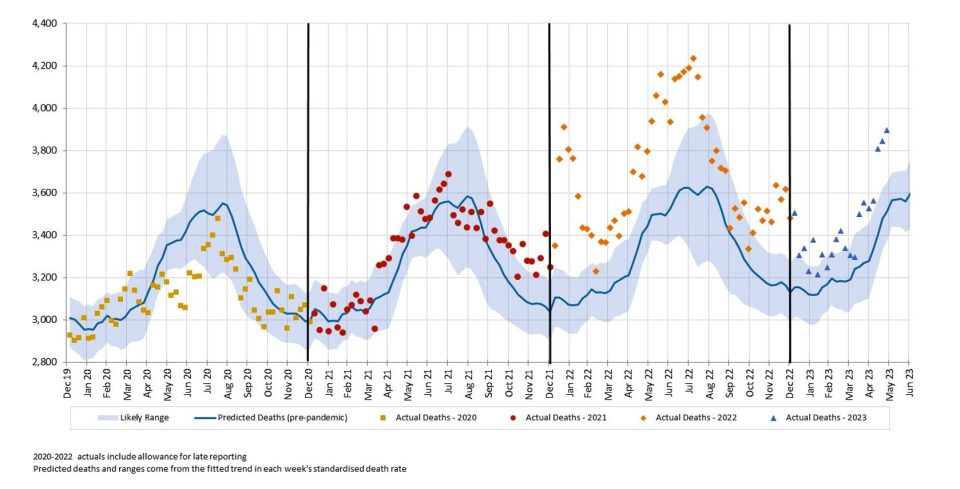
The last three weeks of May were well above the upper end of the 95% prediction interval.
Figure 2 shows deaths from COVID-19 and COVID-19 related deaths, noting that, given small numbers, weekly data for COVID-19 related deaths is not available for 2020 or 2021.
Figure 2 – Weekly deaths from COVID-19 and COVID-19 related*
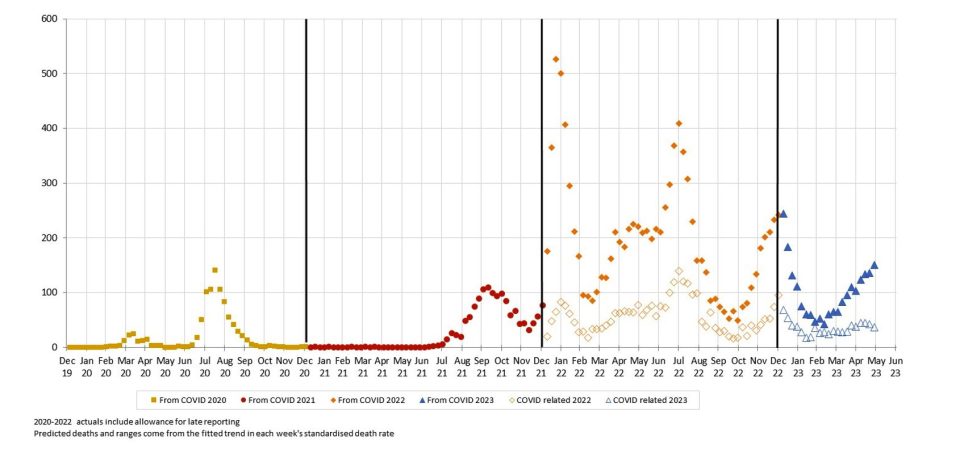
* COVID-19 data from ABS customised report 2023. Predicted COVID-19 deaths are zero as our baseline is intended to represent predicted deaths in the absence of the pandemic.
Deaths from COVID-19 have continued to increase since the low in early March 2023.
Since early 2022, COVID-19 related deaths have broadly followed the same pattern of peaks and troughs as from COVID-19 deaths, however COVID-19 related deaths in the last 10-12 weeks shown have not increased to the same extent as from COVID-19 deaths.
Surveillance reporting indicates that COVID-19 deaths peaked around the last week of May/first week of June before declining again through June and July. Hence, it is likely that the May/June 2023 peak in COVID-19 deaths will be lower than earlier COVID-19 peaks and that the shape will be broader.
Figure 3 compares actual and predicted deaths, after removing deaths from COVID-19 and COVID-19 related deaths.
Figure 3 – Weekly actual and predicted deaths – All causes excluding deaths from COVID-19 and COVID-19 related deaths
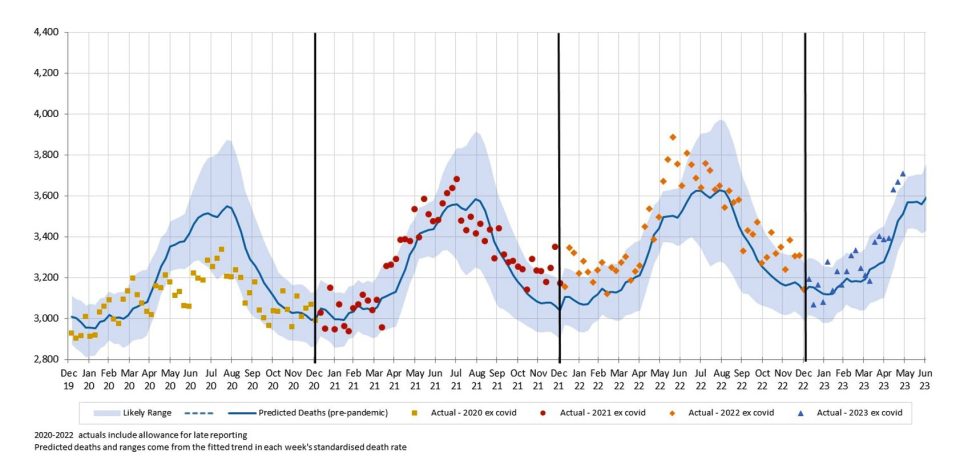
Non-COVID-19 deaths were above predicted levels for the last three weeks of May 2023. Even though the May/June 2023 peak in COVID-19 deaths is not as high as earlier peaks, the impact on non-COVID-19 deaths appears similar – the times of peak COVID-19 deaths are the times when non-COVID-19 deaths exceed the 95th percentile.
Excess deaths to 31 May 2023 by cause of death
Table 1 shows our estimate of excess deaths broken down by cause. We have shown the figures for the first five months of 2023 plus the full year 2022. We have shown actual deaths broken down into those that are either from COVID-19 or COVID-19 related (“Covid”), and those without COVID-19 on the death certificate (“non-Covid”)[1].
Figure 4 shows the 95% confidence interval around the estimates for the 2023 year-to-date. We have shown the all-cause excess mortality both including and excluding deaths from COVID-19.
Table 1 – Excess deaths in Australia – by cause of death for 2023 year-to-date and for 2022
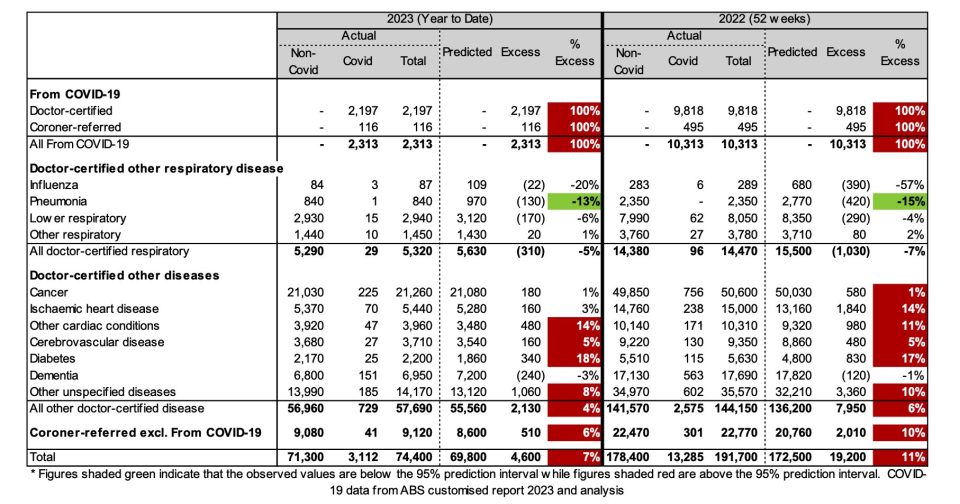
Figure 4 – Excess deaths by cause of death in 2023 year-to-date – 95% prediction intervals
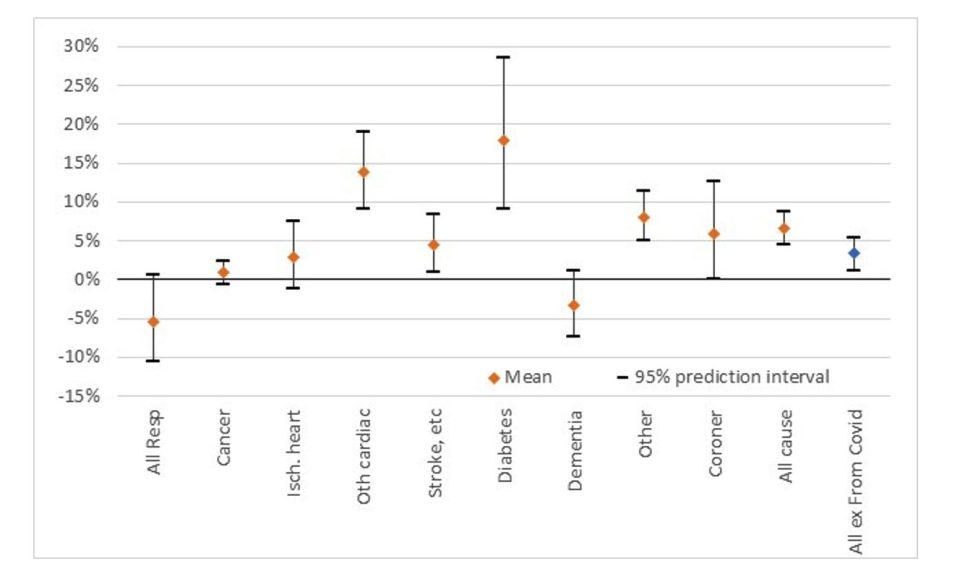
In the first five months of 2023:
- total deaths were 7% (95% confidence interval: 4% to 9%) or +4,600 higher than predicted. 1,000 of these excess deaths occurred in January (7% excess), 500 in February (4% excess), 800 in March (6% excess), 1,000 in April (7% excess) and 1,500 in May (10% excess);
- there were 2,313 deaths from COVID-19, representing 50% of the excess deaths;
- there were 799 COVID-19 related deaths included among the other causes of death (3,112 less 2,313), representing a further 17% of the excess deaths. The remaining 33% of excess deaths (c. 1,500) have no mention of COVID-19 on the death certificate; and
- doctor-certified deaths from other cardiac conditions, cerebrovascular disease, diabetes, other unspecified diseases and coroner referred deaths were all significantly higher than predicted (by between 5% and 18%). Deaths from pneumonia were significantly lower than predicted (by 13%).
Figure 5 shows excess deaths (as a percentage of predicted) for each month of 2022 and 2023. The dotted lines indicate preliminary estimates of COVID-19 deaths and total excess deaths for June and July 2023 (based on both surveillance reporting and the information contained in the ABS article COVID-19 Mortality in Australia). We have shown the total excess (blue) and the contributions of:
- deaths from COVID-19 and COVID-19 related deaths (orange), noting that Figure 2 showed that deaths from these two sources broadly move in the same pattern;
- deaths from respiratory disease (yellow); and
- deaths from all other causes (grey).
Figure 5 – Excess deaths (% of predicted) by month in 2022 and 2023
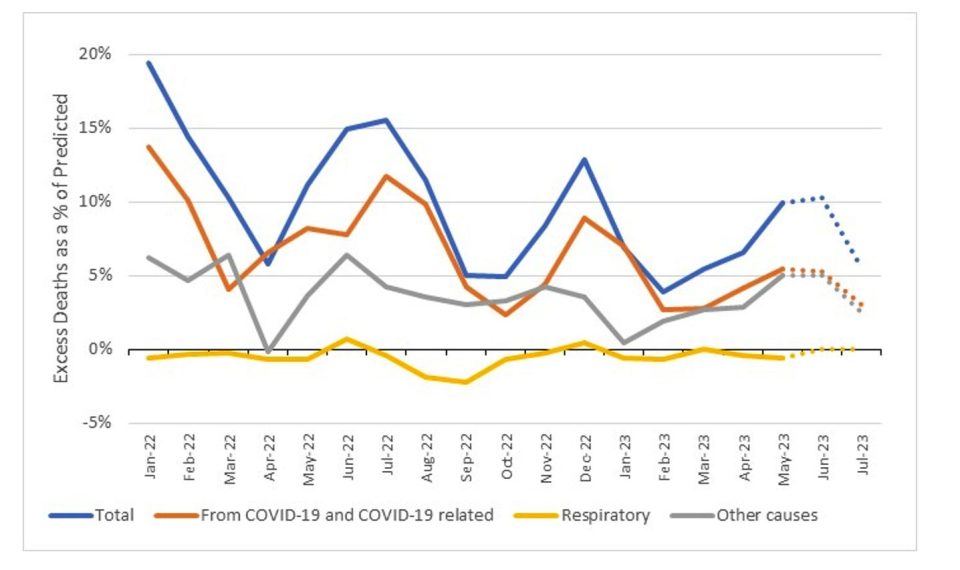
Deaths from COVID-19 and COVID-19 related deaths account for most of the excess mortality. Based on the preliminary COVID-19 figures for June and July 2023, influenza surveillance reporting, and the persistence of non-COVID-19 excess mortality, we expect that total excess mortality for these months is likely to be around 10% (June) and 6% (July).
Deaths from respiratory disease have mostly been a negative contributor to excess mortality. We can see the impact of the early, lighter than average, influenza season in 2022 with a small contribution to excess mortality in June 2022, more than offset by high negative contributions in August and September 2022 (the months where influenza deaths usually peaked before the pandemic).
Influenza surveillance reporting for 2023 indicates that, although the 2023 flu season started around two weeks later than in 2022, it is again earlier than pre-pandemic normal. 2023 hospitalisations peaked over about an eight-week period from end-May to mid-July, which is longer than the peak of around five weeks from mid-May to mid-June in 2022.
This is shown in Figure 6, extracted from the most recent surveillance report[2].
Figure 6 – Number of influenza hospitalisations at sentinel hospitals

Figure 7 compares influenza deaths as included in the Department of Health and Aged Care surveillance reporting (“DHAC”) and as recorded on death certificates via the ABS reporting. Each line represents a different calendar year, showing the cumulative number of deaths in the year.
Figure 7 – Cumulative influenza deaths by year – surveillance versus death certificates

To 20 August 2023, 214 surveillance influenza deaths were reported, which is a little lower than the approximately 260 deaths reported by a similar point in the 2022 influenza season.
Therefore, we expect that respiratory disease will have a negligible contribution to excess mortality in June 2023 and July 2023, and then similar negative contributions in August and September as for 2022.
Excess mortality from other causes (i.e., non-COVID-19, non-respiratory), somewhat follows the pattern of COVID-19 mortality; it tends to be higher when COVID-19 (and respiratory) deaths are high and lower when COVID-19 deaths are low. However, the relationship is not 100% correlated – e.g., there was substantial non-COVID-19, non-respiratory excess mortality in September and October 2022 when both COVID-19 and respiratory deaths were relatively low.
Excess deaths to 31 May 2023 by age band and gender
Table 2 shows our estimate of excess deaths broken down by age band and gender. We have shown the figures for the first five months of 2023 plus the full year 2022, with the contribution of COVID-19 deaths shown separately.
As discussed in our Research Paper, we have to use a more approximate method to estimate excess deaths by age band/gender due to the data available. There are therefore small differences in the totals shown in Table 1 and Table 2. Our cause of death models represent our best estimate of the total excess mortality.
Figure 8 shows the 95% confidence interval around the estimates for the 2023 year-to-date, both including and excluding deaths from COVID-19 and COVID-19 related deaths.
Table 2 – Excess deaths in Australia – By age band/gender for 2023 year-to-date and for 2022

Figure 8 – Excess deaths by age band/gender in 2023 year-to-date – 95% prediction intervals

In the first five months of 2023:
- there is no significant excess mortality in the 0-44 or 45-64 age bands for either males or females;
- in the 85+ age band for males, the excess mortality is wholly attributable to COVID-19 while for females the excess is not statistically significantly different from zero once COVID-19 is removed; and
- for the 65-74 and 75-84 age bands, around one quarter to one-third of the excess mortality is attributable to COVID-19. It is these two age bands where significant non-COVID-19 mortality is apparent in 2023, with a higher excess in females compared with males.
Data and terminology
The COVID-19 Mortality Working Group has examined the latest Provisional Mortality Statistics, covering deaths occurring prior to 31 May 2023 and registered by 31 July 2023, released by the Australian Bureau of Statistics (ABS) on 25 August. This release also includes the article COVID-19 Mortality in Australia, with details on all COVID-19 deaths occurring and registered by 31 July 2023.
We have used additional data supplied by the ABS in a customised report in relation to COVID-19 deaths registered by 31 July 2023, namely the total number of deaths each week (doctor-certified and coroner-referred) both from COVID-19 and COVID-19 related, defined as:
- deaths from COVID-19 are deaths where COVID-19 is listed as the primary/underlying cause of death; and
- deaths that are COVID-19 related are deaths where the underlying cause of death has been determined as something other than COVID-19, but COVID-19 was a contributing factor mentioned on the death certificate.[3]
Baseline predictions
We calculate excess deaths by comparing observed deaths to our “baseline” predicted number of deaths for doctor-certified deaths (by cause) and coroner-referred deaths (for all causes combined). As always, our intent is for the baseline to reflect the expected number of deaths “in the absence of the pandemic”.
The derivation of our baselines and a fuller description of our methodology is documented in our recently released Research Paper. In short, our baselines by cause of death are set by extrapolating linear regression models fitted to Standardised Death Rates (SDRs), which are then re-expressed as numbers of deaths. That means that our baselines allow for changes in the size and age composition of the population, plus the continuation of pre-pandemic mortality trends.
Disclaimer
This monthly COVID-19 mortality analysis is intended for discussion purposes only and does not constitute consulting advice on which to base decisions. We are not medical professionals, public health specialists or epidemiologists.
To the extent permitted by law, all users of the monthly analysis hereby release and indemnify The Institute of Actuaries of Australia and associated parties from all present and future liabilities
COVID-19 Mortality Working Group
The members of the Working Group are:
- Karen Cutter
- Jennifer Lang
- Han Li
- Richard Lyon
- Zhan Wang
- Mengyi Xu
References
[1] As in our previous work, we have estimated the number of coroner-referred COVID-19 deaths based on the experience of late 2021 and the emerging experience in 2022. If our estimate of coroner-referred COVID-19 deaths is too high (or low), this will not affect the total level of excess deaths measured; it will just mean that our estimate of non-COVID-19 coroner-referred deaths will be too low (or high) by the same amount.
[2] Department of Health and Aged Care, Australian Influenza Surveillance Report, Communicable Disease Epidemiology and Surveillance Section (CDESS), Report no. 10, 2023.
[3] The COVID-19 deaths covered in this article are distinct from “incidental COVID-19” deaths, namely deaths where the person was COVID-19 positive at the time of death, but COVID-19 was not recorded on the death certificate. These deaths are generally included in surveillance reporting where identified (other than where there is a clear alternative cause of death, such as trauma) but are not separately identified in the ABS statistics.
CPD: Actuaries Institute Members can claim two CPD points for every hour of reading articles on Actuaries Digital.






